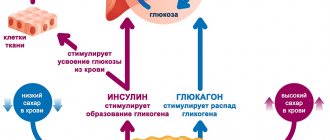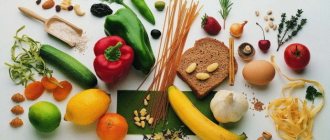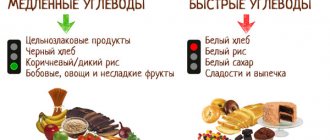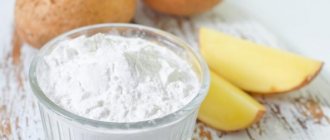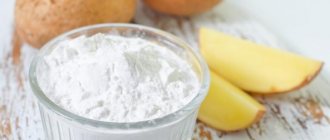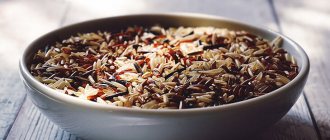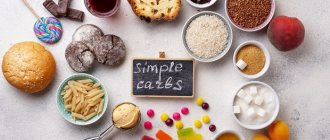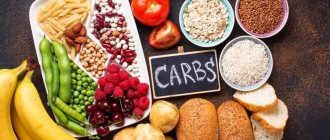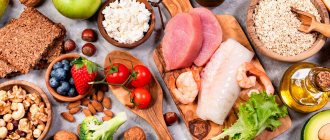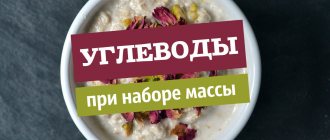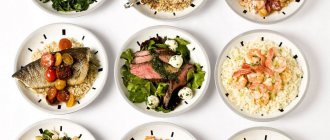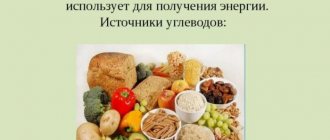From this article you will learn:
- Difference between fast and slow carbohydrates
- Fast carbohydrates in the human diet
- Glycemic index indicator
- The benefits and harms of fast carbohydrates
- Products containing fast carbohydrates
- Principles of eating foods with fast carbohydrates
Products containing fast carbohydrates can be both harmful and beneficial - it all depends on the situation. Although, by and large, experts do not recommend abusing such food in any case, this can negatively affect a person’s well-being.
However, to maintain a healthy lifestyle, you need to know exactly which foods to avoid and why. As for the second question, the point here is not only to eliminate the possibility of getting fat deposits on the sides, but also to take care of your endocrine system. However, let's talk about everything in order.
Difference between fast and slow carbohydrates
Carbohydrates are organic compounds, one of the main sources of human energy, brain nutrition and cell growth. They are divided into two types:
- Simple (fast)
. They are called that because they are very easily absorbed by the body. They cause a sharp increase in blood sugar, give an instant boost of energy, but after a fairly short period of time the person feels hungry again.
- Difficult (slow)
. They have a low rate of absorption by the body, due to which they give a lasting feeling of fullness and provide the body with energy for a longer time. A person may not feel hungry for 4 hours.
The difference between fast and slow carbohydrates
Nutrition experts advise basing your diet on foods containing slow carbohydrates because of their ability to make you feel full for a long time. But you shouldn’t go to extremes: you don’t need to completely eliminate fast carbohydrates from consumption, since abruptly abandoning them can lead to breakdowns. You just need to make sure that your diet consists of 85–90% healthy dishes.
Low carb diets
As was said at the beginning, low-carbohydrate diets today are often used for medicinal purposes - not only for weight loss, but also for correcting insulin resistance and combating type 2 diabetes.
Reducing carbohydrates in food by eliminating fast carbohydrates leads to overall vascular health, reduces insulin surges, and allows you to maintain a stable feeling of fullness after eating without harming your figure, since slow carbohydrates fill you up for a longer period, just like proteins and fats.
We recommend
“Nutrition for diarrhea: top 10 foods to help” Read more
Variations of the low-carb diet are LCHF and the keto diet. LCHF is a lighter version of the keto diet, consisting of 70% fat, 20% protein and 10% carbohydrates. While LCHF allows up to 50 grams of carbohydrates per day, the keto diet limits you to 10 grams of carbohydrates per day.
Low-carb diets limit:
- Sugar, honey and artificial sweeteners (the harmlessness of stevia is greatly exaggerated, sweeteners increase appetite, support cravings for sweets, and sugar is not at all what is needed for a healthy body).
- Sweet carbonated drinks.
- Yeast bread, pastries.
- Cereals, porridges, flakes, breakfast cereals.
- Skim milk, kefir, yogurt.
- Sweet curds.
- Margarine, spreads with trans fats.
Authorized products:
- Butter, coconut, vegetable oil.
- High-fat dairy and fermented milk products (sour cream, cream, cottage cheese).
- Fatty meats, poultry (with skin).
- Salo.
- Broths.
- Boiled pork, bacon, jamon, balyk.
- Fish (mackerel, salmon, herring, salmon) and seafood (clams, shrimp, squid).
- Eggs.
- Fatty hard and soft cheeses.
- Avocado.
- Sauces, homemade mayonnaise.
- Mushrooms.
- Vegetables.
- Nuts, nut butters.
- Leaf salads (lettuce, spinach, lollo rossa, iceberg, arugula and others).
- Sour berries.
- Any sources of additional fiber (bran, psyllium).
- Shirataki noodles.
- Olives, olives.
Fast carbohydrates in the human diet
Simple carbohydrates consist of one or two molecules and have a high GI (glycemic index). They taste sweet and tend to dissolve well in water.
This is interesting!
“Fructose: benefits and harm to the body + consumption standards” Read more
Simple carbohydrates are divided into monosaccharides and disaccharides. In turn, monosaccharides are classified into two groups:
- Glucose
. It is converted into glycogen in the liver and muscles and is a source of energy for the entire body. Glucose is found in berries, grapes, sweet vegetables (carrots, potatoes, corn).
- Fructose
. Before being converted into energy, the body converts fructose into glucose, making it less digestible. Contained in ripe vegetables and fruits, honey.
Three studies that will help stop aging
Such a simple element as water has always been considered vital and necessary.
But at the same time, the number of myths about water, scientific facts and opinions that are imposed every day and then refuted, encourages us to look for answers to our questions. To help you, my team and I have prepared a webinar and a gift: 3 unique materials based on the experience of our experts on prolonging youth with the help of water. After completing our free webinar you will learn:
Artyom Khachatryan
practicing physician-nutritionist, naturopath
Immediately after registration you will receive a selection of studies:
Aging: you can't stop it, you can't accept it
What conclusions did 21st century scientists come to when studying water and its ability to prolong youth?
In fact, we don't know anything about water.
Important information for prolonging youth that we could have been told back in school
Hydrogen water is the most powerful natural remedy for prolonging youth
Why hydrogen-enriched water is considered the most effective, safe and affordable way to prolong youth
Find out how water can take care of your health, youth and beauty at a free webinar by nutritionist Artyom Khachatryan!
Disaccharides are also divided into two groups:
- Maltose
, which is malt sugar. Its content is high in oranges and beer.
- Sucrose
, which is found in almost all plants. Most of all it is found in all types of sugars - beet, brown, cane; in smaller quantities – in vegetables and fruits.
Glycemic index indicator
The glycemic index (GI) is an indicator that reflects the rate at which carbohydrates are absorbed by the body. The term itself was coined by Canadian nutritionist David Jenkins at the end of the last century; it is relevant primarily for diabetics, since it is precisely people suffering from this disease who need to correctly monitor any sugar entering the body.
As a result of long studies, during which the reaction of blood sugar levels to the intake of glucose in its pure form was studied, tables were obtained with glycemic index data for a wide variety of foods.
In his research, David Jenkins revealed the dependence of a person’s well-being on the amount of carbohydrates consumed. With a normal level of glucose in the blood, active performance and a cheerful state are observed. If sugar rises or falls sharply, this is manifested by a decrease in activity and a feeling of fatigue. Conclusion: to maintain excellent well-being and an energetic state, it is necessary to control the level of sugar and insulin in the blood and avoid sudden jumps.
To classify foods according to the glycemic index, we took a glucose GI value of 100 as a basis and divided into three index categories:
- low – below 55;
- average – from 55 to 70;
- high – over 70.
Glycemic index indicator
Constant excessive consumption of foods with a high GI and, accordingly, containing fast carbohydrates, negatively affects the overall well-being and health of a person. They do not nourish the body qualitatively, but only give a short-term feeling of fullness.
In addition, if the sugar that enters the blood is not converted into glycogen through physical activity, then there is a risk of turning it into fat deposits. It is for these reasons that it is recommended to consume fast carbohydrates in limited quantities.
When there is a question about losing weight, it is necessary to structure your diet in such a way that the bulk of it consists of foods with a low GI, less than 55. In addition to a slim figure, a person will receive excellent well-being as a bonus.
The benefits and harms of fast carbohydrates
A person receives most of his energy from food, in particular by consuming carbohydrates. Despite the fact that foods containing fast carbohydrates supply the body with energy only for a short period of time, there are situations when a quick burst of strength is needed here and now. How foods with a GI of 70 or higher can help:
- have a positive effect on brain activity;
- replenish glycogen reserves;
- necessary for metabolic processes;
- help cope with blues and depressed mood;
- improve the production of happiness hormones - dopamine and serotonin;
- prevent harmful substances from entering the body.
How to Guaranteed Lose Weight with Water: 3 Simple Habits
There are almost no women in the world who have never been on a diet. Sooner or later, everyone faces the desire to lose a couple of kilograms.
In order for the treasured number to appear on the scales sooner, introduce 3 healthy and super simple habits into your life: we have prepared a document with experts where we describe them in detail.
Artyom Khachataryan
Practitioner, nutritionist, naturopath
75% of our course participants who follow these habits have significantly reduced their weight!
You can download the document for free:
Also, foods with a high GI should be included in their diet for people leading a sports lifestyle with frequent intense physical activity.
The benefits and harms of fast carbohydrates
In the field of bodybuilding, the concept of a “carbohydrate window” has even been introduced. This is approximately a half-hour period after the end of training, when athletes should have time to eat a gainer (carbohydrate-protein cocktail) or eat a product containing fast carbohydrates.
With the help of pancreatic hormones, glucose enters the muscles, feeding them with energy and slightly increasing the size of the cells, which, in fact, is what a bodybuilder needs. This starts recovery processes that promote muscle mass gain.
However, if the muscle cells are already overcrowded, the excess energy has nowhere to go and will turn into fat deposits on the body.
For people leading a sedentary lifestyle, uncontrolled consumption of fast carbohydrates can seriously affect their health. Eating foods with a high GI - baked goods, sweets, cakes - overloads the pancreas, which is responsible for producing insulin. Problems with the endocrine system may begin. Blood sugar surges begin, which affect your mood and well-being, causing irritation and fatigue.
This is interesting!
“Nitrates in vegetables: truth and fiction” Read more
Products containing fast carbohydrates do not provide any benefit to the body, since they contain practically no vitamins and microelements, and their calorie content is extremely high. The only exceptions are fruits and honey. However, this does not mean that they can be eaten without restrictions. Those with a sweet tooth need to be especially attentive to their health, since excessive consumption of useless calories can lead to obesity, pancreatitis and diabetes.
Which vegetables are easily digestible?
Vegetables are used daily in the diet; they contain useful elements and are easily processed. The body processes green leafy vegetables the fastest. They contain substances that help speed up the digestion process, so it is useful to eat leafy salads as a side dish.
The most easily digestible vegetables:
- asparagus;
- spinach;
- leaf salads;
- carrot;
- beet;
- zucchini;
- pumpkin;
- green bean.
Fruits and vegetables contain a large amount of fiber, which speeds up the digestion process. Therefore, they are considered the most easily digestible foods.
Products containing fast carbohydrates
To reduce the risk of pancreatic diseases and prevent your body from becoming swollen with fat, you need to review your diet and eliminate most of the fast-carbohydrate foods, replacing them with healthy foods.
Products containing fast carbohydrates
Even without delving into the glycemic index, we can separate foods containing fast carbohydrates into a separate list:
- white wheat flour products;
- sausages;
- bee products;
- sweet products containing preservatives (carbonated drinks, candies);
- instant pasta from soft wheat varieties;
- potatoes in any form (fried, fried, boiled);
- vegetables that have been subjected to heat treatment (starch appears in them);
- canned fruits with added sugar and compotes;
- alcoholic drinks;
- any desserts with sugar (ice cream, jam, jam) and sugar itself in its pure form;
- quick snacks, dishes from fast food restaurants (they contain a lot of sugar and starch);
- many types of flour, including wheat, rice, corn;
- breakfast cereals;
- zucchini caviar;
- condensed milk;
- sweet dried fruits: dates, raisins, dried apricots, peaches and pears.
If you cannot completely get rid of the consumption of the listed foods containing fast carbohydrates, then you need to try to at least reduce their appearance on the table to the very minimum. Not the least role in the benefits of products is played by the methods of their preparation.
As a rule, the higher the temperature and the longer the processing time, the greater the likelihood of sugar appearing in the dish in finished form. For example, it is healthier to boil potatoes in their skins than to prepare mashed potatoes or, especially, French fries. Following the principles of a healthy diet will help prevent excess weight gain.
In cases where it is necessary to strictly observe restrictions on the consumption of foods with fast carbohydrates, it is necessary to rely on glycemic index indicators when compiling a diet. The GI indicators of foods containing large quantities of fast carbohydrates can be viewed in a special table. For example:
| Product | Glycemic index indicator | Amount of carbohydrates per 100 grams of product |
| Spirits (average) | 116 | 0-50 |
| Watermelon | 102 | 8 |
| Canned apricot | 90 | 67 |
| Bread made from white flour | 135 | 52 |
| Special buns for sandwiches | 87 | 50 |
| Swede | 88 | 8 |
| Legumes | 79 | 9 |
| Baking and confectionery products, cakes (on average) | 102 | 70 |
| Corn syrup | 114 | 77 |
| Carbonated drinks | 100 | 12 |
| Potatoes in any form: fried, boiled, fries | 94 | 27 |
| Starch | 94 | 84 |
| Cracker cookies | 81 | 68 |
| Boiled corn | 76 | 23 |
| Zucchini | 74 | 5 |
| Zucchini caviar | 74 | 9 |
| Semolina | 74 | 74 |
| Compote | 71 | 15 |
| Brown sugar | 70 | 97 |
| Canned fruits | 70 | 68-75 |
| Rice pasta | 90 | 84 |
| sucking candy | 79 | 98 |
| Bee products | 89 | 81 |
| Pasta | 89 | 74 |
| Wheat flour | 87 | 72 |
| Rice flour | 78 | 81 |
| Corn flour | 70 | 74 |
| Boiled carrots | 84 | 5 |
| Sweet breakfast cereals | 79 | 65 |
| Ice cream | 70 | 23 |
| Low alcohol drinks (beer) | 115 | 0-53 |
| Parsnip | 97 | 9 |
| Canned peaches | 92 | 67 |
| Squash | 75 | 5 |
| Cakes | 75 | 76 |
| Millet | 71 | 76 |
| White rice | 90 | 77 |
| Turnip | 84 | 6 |
| Glazed cheese | 70 | 10 |
| Juices | 74 | 8 |
| Crackers | 74 | 72 |
| Celery | 86 | 3 |
| Sugar | 100 | 100 |
| Pumpkin | 75 | 5 |
| Dates | 145 | 73 |
| Chocolate candies | 70 | 73 |
Sample menu on a low-carb diet
Monday
Breakfast
: omelet of 3-4 eggs; salad (tomato, cucumber, mozzarella, paprika); homemade cottage cheese with sour cream; coffee with cream.
Dinner
: several varieties of hard cheese; nuts; coffee with cream or tea.
Dinner
: pickles; pork neck or lamb kebab; grilled cheese; glass of dry wine.
Before bedtime
: a cup of tea with cream
Tuesday
Breakfast
: oatmeal on water with unroasted almonds (7-8 nuts), green tea.
Snack
: grated carrots with lemon juice and olive oil.
Dinner
: baked chicken breast (200 grams), salad of boiled beets (1 piece), arugula, olive oil and cucumber.
Snack
: small peach or 2-3 apricots.
Dinner
: stewed green beans without oil, salad of any green vegetables with 1 spoon of sour cream.
Wednesday
Breakfast
: boiled buckwheat, green tea.
Snack
: grapefruit and a handful of unroasted almonds.
Dinner
: boiled cod (250 grams), cabbage salad, carrots and 1 boiled egg with olive oil.
Snack
: 2 large green apples.
Dinner
: stewed zucchini and salad of any green vegetables.
Thursday
Breakfast
: low-fat cottage cheese (200 grams), 5-6 seasonal berries, green tea.
Snack
: a handful of unroasted hazelnuts, cucumber and tomato salad.
Dinner
: baked turkey (200 grams), avocado salad and any green vegetables.
Snack
: 2 boiled eggs.
Dinner
: stewed broccoli and salad of boiled beans, herbs and tomatoes.
Friday
Breakfast
: oatmeal in water with an apple and 4 walnuts, green tea.
Snack
: homemade yogurt without additives.
Dinner
: baked perch (200 grams), salad of tomatoes, cucumbers and fresh cabbage with olive oil.
Snack
: 2 large green apples.
Dinner
: beef stew (250 grams), seasonal vegetable salad.
Saturday
Breakfast
: homemade yogurt, 1 large pear, 5-6 pieces of unroasted almonds, green tea.
Snack
: stewed vegetables (200 grams).
Dinner
: cream pumpkin soup, boiled chicken and greens salad.
Snack
: 1 boiled egg, a slice of low-fat cheese.
Dinner
: baked eggplants, fresh cabbage, cucumber and radish salad.
Sunday
Breakfast
: oatmeal on water with unroasted almonds (7-8 nuts), green tea.
Snack
: grated carrots with lemon juice and olive oil.
Dinner
: baked chicken breast (200 grams), salad of boiled beets (1 piece), arugula, olive oil and cucumber.
Snack
: small peach or 2-3 apricots.
Dinner
: stewed green beans without oil, salad of any green vegetables with 1 spoon of sour cream.
Principles of eating foods with fast carbohydrates
To ensure that eating foods containing fast carbohydrates causes as few problems as possible for you and your waistline, try to follow two rules:
- Eat foods containing sugar in the morning and early afternoon
. There is a high probability that throughout the day the body will completely convert the glucose received in the morning into energy and will not send it to be deposited on the sides. However, this scheme will not work with fast carbohydrates eaten in the evening. Therefore, avoid sweet foods at night.
- Look for a healthy substitute for sweet desserts
. For example, foods containing pectin, fiber and proteins slow down the absorption of sugar. Take advantage of this, choose the lesser of two evils: a baked apple, marshmallows or cottage cheese with dried fruits may well be a worthy alternative to a “Potato” cake or a tube of cream.
Two points, two simple actions, don’t neglect them, and you will love your reflection in the mirror.
Principles of eating foods with fast carbohydrates
Let's remember everything that was said in this article and briefly formulate the conclusion. In very rare cases, foods containing fast carbohydrates are necessary and have a positive effect on the body. As a rule, such situations arise in athletes while gaining muscle mass or in people with high physical activity.
An increase in blood sugar causes pancreas hormones to work and deliver nutrients directly to muscle cells. In this case, insulin triggers the recovery processes necessary for muscle growth.
In the vast majority of cases, fast carbohydrates are empty calories for the body, not containing any nutrients or beneficial elements. In addition, excessive and improper consumption of foods containing fast carbohydrates is dangerous to health and is fraught with the development of diabetes mellitus and diseases of the endocrine system.
